Suzanne Woods Fisher's Blog, page 26
October 4, 2017
Wednesday Wonderings: Blessed Lulls
I became a first-time grandmother at age 51. At that time, I only had one friend who was also a new grandmother. Even now, most of my friends are still wishing, and hoping, and waiting…
Here’s what I like to tell my friends who are in that “lull stage” (post empty-nest, weddings have started, no grandchildren yet): You’ve been given a gift of time right now, a blessed lull. For most of your life, there’s never enough time! Soon enough, the grandbabies are going to start coming and life will never be the same. In a wonderful way!

For now, cherish the quiet house, the manageable calendar, the empty closets…the blessed lull.
What about you? Have you had “lulls” in your life? What lessons have you learned from them?





October 2, 2017
Celebrating Fall with Historical Fiction: Winners

I had so much fun hosting Celebrating Fall with Historical Fiction—I hope you had just as much fun!
Below you will find the list of winners (all winners have been contacted)! Thank you to everyone who participated!
Melody Carlson’s The Christmas Blessing — Tina Rice
Jan Drexler’s Naomi’s Hope — Lynn Tolles
Jane Kirkpatrick’s All She Left Behind — Brandi Dagwan
Joanna Davidson Politano’s Lady Jane Disappears — Anna Deaton
Christine Johnson’s Freedom’s Price — Elly
Ann Gabhart’s These Healing Hills — Jordann Langness
Karen Witemeyer’s Heart on the Line — Jana Leah
Maggie Brendan’s Trusting Grace — Patricia Bond
Rosanna White’s A Name Unknown — Aston Hayes
Suzanne Woods Fisher’s The Return — Faith Creech
Sarah Sundin’s When Tides Turn — Megan Stalhood





September 25, 2017
Author Spotlight with Laura Taggart
Scroll down for a chance to win a copy of Laura Taggart’s book, Making Love Last:Divorce Proofing Your Young Marriage. Winner will be announced in the next Author Spotlight feature. Congratulations to winner of last Author Spotlight of A Name Unknown, Cathy! Please e-mail your mailing address to my assistant Christen (christenkrumm@gmail.com).

With thirty years of experience as a licensed marriage and family therapist, Laura Taggart understands the unique struggles of newly married couples who find marriage much more difficult than they imagined. Failed expectations, unanticipated conflict, and disagreements about money, sex, children, and more have many young couples assuming they made a mistake, married the wrong person, or just weren’t ready. As a result, one-third of all married couples divorce before their ten-year anniversary.
In this practical and hopeful book, Taggart offers the wisdom and help she would share as a counselor with a couple beginning their marriage. She helps couples examine their true expectations for marriage, provides six action steps for improving the way couples relate, and gives couples a new picture of what it means to enjoy marriage for a lifetime.
Each chapter includes discussion questions for couples or small groups as well as additional questions for personal reflection.
Can you tell us about your newest release?
Yes! My first book, Making Love Last: Divorce-Proofing Your Young Marriage came on on the 4th of July. I wrote it to help young couples get through the hard seasons of their married life. Couples married 5-10 years have a 32% divorce rate. They often have idealized expectations about how they will get along and meet each others needs and when significant conflict emerges, they feel unequipped to handle it and can assume they’ve married the wrong. My book offers a new way of thinking about marriage and practical skills to get them through the rough times.
Is it part of a series or a stand-alone?
I’m hoping to write a second book for couples with teens and kids in early college, facing the empty nest, as it’s another time of marital disillusionment.
Is anything or anyone in this book based on real-life experiences?
I’ve been a Marriage and Family Therapist for 30 years, so much of what I write about are the struggles of couples I have counseled. Although names and identities are changed to preserve confidentiality the issues the couples face in the book are real.
What was the hardest scene in this book to write? What made it difficult?
The dialogue between couples was challenging. I gleaned from fiction writing how to make them more colorful and engaging.
Purchase your copy here:
Amazon | Barnes and Noble | CBD | LauraTaggart.com
Laura Taggart is a Licensed Marriage and Family Therapist with over thirty years of counseling couples and families. She has been “in the trenches” with hundreds of couples, from those who are highly conflicted, recovering from infidelity, on the verge of calling it quits to those who want to make a good marriage better. Laura sees marriage as a profoundly transformative relationship, which, with courage, maturity, and tenacity, can change us into distinctly more authentic and intimate partners. She also has a heart for encouraging parents in the trenches of raising kids and helping families to thrive.
Laura graduated from Fuller Theological Seminary with her Masters in Theology in 1982 and integrates her theological background and Christian spirituality in her work as a therapist and author. She has been an adjunct professor of counseling at Fuller Theological Seminary in Northern California and the Evangelical Theological College of Addis Ababa, Ethiopia.
Website | Pinterest | Facebook





September 22, 2017
Celebrating Fall with Historical Fiction | BONUS Sarah Sundin


One of the many reasons I enjoy writing about the World War II era is because it’s a fascinating time for women’s stories. The needs of a nation at war led women to take on new roles, stretching themselves.
In my latest novel, When Tides Turn, Tess Beaumont needs stretching and she knows it. Pretty and peppy, she’s used to good things falling into her lap. But she’s tired of being seen as merely decorative. All around her, women are contributing to the war effort, and she’s busy selling blouses at Filene’s in Boston. When the US establishes the WAVES program, Tess enlists, determined to make a difference in the world. To be useful.
On July 30, 1942, President Franklin D. Roosevelt signed legislation creating the WAVES (Women Accepted for Volunteer Emergency Service), the women’s branch of the US Naval Reserve. A few days later Lt. Cdr. Mildred McAfee, president of Wellesley College, was sworn in as the first director. At the end of August, the first women began officer training, and training for enlisted women soon followed.
Researching the WAVES for When Tides Turn was fascinating. Although few official histories are available, personal stories abound, full of color. The women were baffled and amused by naval traditions and terminology—as the mother of a sailor in the US Navy, I relate—but the ladies learned and adapted. And of course, they formed deep and lasting friendships.
Looking back through time, we see how valuable these women were and how much they aided the war effort. So I was surprised to read about how much opposition the WAVES faced. The US Navy showed no interest in enlisting women, although women had served with distinction in World War I. At the start of World War II, only the Bureau of Aeronautics and the Chief of Naval Operations, Adm. Ernest King, wanted women in the Navy.
The objections sound shocking to us nowadays. Officers believed women didn’t have the capacity for the technical work required in the Navy. They believed women would be distracted by the handsome sailors—and more importantly from their standpoint, that pretty women would distract the sailors from their duties. Also, some civilians bristled at the thought of women in uniform, believing military service would destroy femininity or that servicewomen would be nothing but “camp followers.” Many others worried about placing their daughters in harm’s way.
Congress intervened and passed the legislation, and the president signed it. Women flooded the recruiting offices, eager to serve their country. Admittedly, the smart uniforms by top designer Mainbocher were an excellent recruiting tool.
To ease the concerns of the nation and of the Navy brass, the WAVES were restricted to serving stateside and not on ships or in aircraft. Initial regulations forbade the WAVES from marrying men in the Navy, to discourage flirting on duty. Tess Beaumont embraces that restriction—she wants to kill her crush on no-nonsense officer Lt. Dan Avery, who’s already married—to the Navy.
On November 6, 1942, the first WAVES reported for duty and immediately showed their worth. They proved the naysayers wrong with their professionalism, competence, and focus. By taking on noncombat positions, the women fulfilled the promise to “free a man to fight,” and soon every branch of the Navy begged for WAVES.
By the end of World War II, 86,000 women served at 900 various stations in dozens of jobs. In September 1944 WAVES were permitted to serve in Hawaii, Alaska, and the Caribbean, and in October 1944 black women were finally accepted into the WAVES. Ultimately, thirty-eight of the sixty-two ratings (jobs) for enlisted sailors were open to women.
As for that restriction against marrying Navy men? Lifted in March 1943.
The WAVES made a vital contribution to the war effort and also to how women were perceived. They showed they could handle highly technical work. They were diligent and competent and professional, while remaining ladies. It was a privilege to write about their struggles, their duties, and their joys. I am thankful for their service.
Author @SarahSundin dives into fascinating research on WAVES. Read about it here #CelebratingFall
Click To Tweet
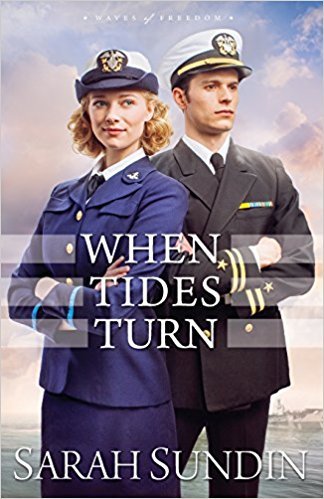 More about When Tides Turn:
More about When Tides Turn:
When fun-loving glamour girl Quintessa Beaumont learns the Navy has established the WAVES program for women, she enlists, determined to throw off her frivolous ways and contribute to the war effort. No-nonsense and hoping to make admiral, Lt. Dan Avery has been using his skills to fight German U-boats. The last thing he wants to see on his radar is a girl like Tess. For her part, Tess works hard to prove her worth in the Anti-Submarine Warfare Unit in Boston–both to her commanding officers and to the man with whom she is smitten. When Dan is assigned to a new escort carrier at the peak of the Battle of the Atlantic, he’s torn between his lifelong career goals and his desire to help Tess root out a possible spy on shore. The Germans put up quite a fight, but he wages a deeper battle within his heart. Could Tess be the one for him?
Purchase a copy here:
Amazon | Barnes and Noble | CBD
 Sarah Sundin is the author of Through Waters Deep and Anchor in the Storm, as well as the Wings of the Nightingale and the Wings of Glory series. A graduate of UC San Francisco School of Pharmacy, she works on-call as a hospital pharmacist. During WWII, her grandfather served as a pharmacist’s mate (medic) in the Navy, and her great-uncle flew with the US Eighth Air Force. Sarah lives in California. Visit www.sarahsundin.com for more information.
Sarah Sundin is the author of Through Waters Deep and Anchor in the Storm, as well as the Wings of the Nightingale and the Wings of Glory series. A graduate of UC San Francisco School of Pharmacy, she works on-call as a hospital pharmacist. During WWII, her grandfather served as a pharmacist’s mate (medic) in the Navy, and her great-uncle flew with the US Eighth Air Force. Sarah lives in California. Visit www.sarahsundin.com for more information.
Website | Facebook | Pinterest | Twitter






Celebrating Fall with Historical Fiction | Roseanna M. White


It’s every historical writer’s nightmare—when you discover that perfect bit of historical fact…too late! Now, the worst-case-scenario is when you discover you’ve made a dreadful, terrible, cringe-worthy error (yeah…been there, done that). Last spring, I rather made a discovery that would have been super fun to include in previous books, but which wasn’t a mistake. What was this fun discovery?
Cockney rhyming slang.
In April, I was on a writing retreat with my best friend/critique partner, working on book 3 in the Shadows Over England Series—book 1, A Name Unknown, was just a couple months from releasing on July 4. I took a moment to look up some Cockney slang. I was really only looking for a nice, simple substitutes for girl. You know, in the line of dame, but which had a London of 1914 flair. What I found was a whole slang tradition that made me want to go back and rewrite my entire series to include it (totally impossible at that point, of course).
Though its origins aren’t quite clear, Cockney rhyming slang is thought to have been created to keep outsiders from knowing what the speakers are saying while also being pure fun to those speakers. The system is pretty simple.
When you want to substitute a word, you start with a rhyming word; then you find a common phrase that contains said rhyming word …and choose the non-rhyming word from that phrase as your substitute.
For instance:
Girl rhymes with twirl. So what’s a phrase that has twirl in it? “Twist and twirl.” So they call a girl a twist.
Wife rhymes (hilariously) with strife. A common phrase at the time that involved strife was “storm and strife.” So wife = storm.
Stairs. Pears. “Apples and pears.” So you might tell someone to go down the apples to fetch you something.
Those are in fact the three examples I chose to incorporate into An Hour Unspent.
Of course, the difficulty of finding something fun like this is the temptation to overuse it. I encountered this same problem many moons ago when I was working on a 20s novel (unpublished). I loved the rich slang of the era, but I couldn’t have each and every character spitting jazz-age phrases out every other line. I instead had one character who considered herself very modern and stylish who incorporated a slew of these slang phrases—“Put on your glad rags, baby, and let’s hit the town. This new speakeasy is the elephant’s instep!” Otherwise, a character might say a slang word here or there, but only when it was one my readers would know, or which wouldn’t be too distracting.
In the Shadows Over England Series, each book features a member of a rather special family of thieves. Most of them are pure Cockney stock, children who were orphaned at young ages and decided to stick together. They grew up together, forged a family through sheer grit and determination, and are now using their, er, rather specific skill sets to aid in the Great War that began in Europe in 1914.
One thing I love about these characters is showcasing the tough, street-smart side of the Edwardian era, especially when pitted against the more genteel set that our novels today usually focus on. In my series, one half of my hero-heroine couple is Cockney, and the other of a gentler society. So obviously, if I want to incorporate Cockney rhyming slang at all, it has to be sparse.
In An Hour Unspent, I have my hero leading my middle-class girl from a far different neighborhood into a Cockney pub, where all his neighbors are calling out, “Who’s the twirl, Barclay? Don’t tell me you’ve found a storm!” My hero himself never uses the slang, but I had oh-so-much fun peppering those few instances in.
And really did wish I could have pulled A Name Unknown off the presses real quick to insert one or two in book 1 of the series as well! Rosemary, you see, is tough and scrappy, a Cockney girl through and through. I can totally imagine her using a few choice phrases of rhyming slang just to confuse a certain busybody in the Cornish town she’s visiting for her assignment in the book. And frankly, I can also imagine hero Peter Holstein being intrigued by it and deciding to incorporate it into one of his novels…
Because we writers just can’t resist fun turns of phrase!
Read about when @RoseannaMWhite discovered Cockney rhyming slang! #CelebratingFall #Giveaway
Click To Tweet
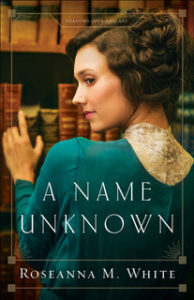 More about A Name Unknown:
More about A Name Unknown:
Edwardian Romance and History Gains a Twist of Suspense
Rosemary Gresham has no family beyond the band of former urchins that helped her survive as a girl in the mean streets of London. Grown now, they concentrate on stealing high-value items and have learned how to blend into upper-class society. But when Rosemary must determine whether a certain wealthy gentleman is loyal to Britain or to Germany, she is in for the challenge of a lifetime. How does one steal a family’s history, their very name?
Peter Holstein, given his family’s German blood, writes his popular series of adventure novels under a pen name. With European politics boiling and his own neighbors suspicious of him, Peter debates whether it might be best to change his name for good. When Rosemary shows up at his door pretending to be a historian and offering to help him trace his family history, his question might be answered.
But as the two work together and Rosemary sees his gracious reaction to his neighbors’ scornful attacks, she wonders if her assignment is going down the wrong path. Is it too late to help him prove that he’s more than his name?
Purchase a copy here:
Amazon | |
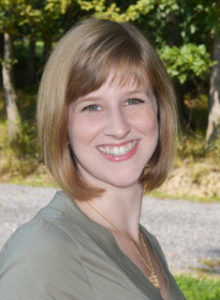 Roseanna M. White pens her novels beneath her Betsy Ross flag, with her Jane Austen action figure watching over her. When not writing fiction, she’s homeschooling her two children, editing and designing, and pretending her house will clean itself. Roseanna is the author of over a dozen historical novels and novellas, ranging from biblical fiction to American-set romances to her British series. Spies and war and mayhem always seem to make their way into her novels…to offset her real life, which is blessedly boring. She passes said boring life with her husband and kids in the beautiful mountains of eastern West Virginia.
Roseanna M. White pens her novels beneath her Betsy Ross flag, with her Jane Austen action figure watching over her. When not writing fiction, she’s homeschooling her two children, editing and designing, and pretending her house will clean itself. Roseanna is the author of over a dozen historical novels and novellas, ranging from biblical fiction to American-set romances to her British series. Spies and war and mayhem always seem to make their way into her novels…to offset her real life, which is blessedly boring. She passes said boring life with her husband and kids in the beautiful mountains of eastern West Virginia.
Website | Blog | Facebook | Twitter | Instagram






September 21, 2017
Celebrating Fall with Historical Fiction | Maggie Brendan


While I was writing Trusting Grace and beginning to develop the character of my heroine’s ailing father, it was as if God himself intruded into the sub-plot development with His own idea of what I was about to write totally changed. You know, it’s been said that a piece of an author finds its way into their writing subconsciously. Either way—in my proposal, I had the ailing father suffering from a stroke, but when I began to write about his symptoms it seemed God had other ideas in mind so I went with it. Who wouldn’t when the creator of the world wrote His love story to us?
I considered what happened that day a truly ‘Divine Appointment’. The centerpiece of my historical romance story is about learning to trust God first then others. It centers on finding love again for my heroine and hero both widowed. It speaks to the depth of character change when the hero and heroine face trials through dependence on God. However, as the sub-plot eked onto the page, I finally acknowledged that I would need to do a little research on a particular topic before I went any further—something I hadn’t intended to do because of the time involved.
To give you a little background—for five years my husband has suffered from a chronic and rare disease, CIDP, Chronic Inflammatory Demyelinating Polyneuropathy. It was clear God wanted me to make CIDP the heroine’s father’s illness and not merely a stroke. Could that have even been a possibility during this historical time frame of 1866? I laughed out loud. I rather doubted it, but to my complete surprise I found that CIDP had its beginning as Multiple Neuritis discovered by Robert Graces in 1843 when little was known about the disease. I also found that some experts believe Franklin D. Roosevelt may have suffered from CIDP instead of polio. Wow, God! He knew all along. I smiled and went back to writing.
So what only started out with a story of love and loss for the hero and heroine also became a story of a father/daughter relationship battling illness with lovingkindness, and the resilience of the caregiver, my heroine, Grace. It’s very true that God gives us more grace than we deserve, but even more so when we are facing huge battles whether it is death, illness, loss of love, job, financial or spiritual crisis. It was no mistake that three years before when I first sent this series proposal to my editor, I named my heroine Grace. You can follow how that became the title now.
Grace became my character’s strength for living. Both of them had brokenness and suffering in their lives—Grace becoming a widow with a farm to run, an ailing father and her loss of hope for family and children—Robert—losing his bride, his wheat farm, then be suddenly saddled with three children of whom he had no prior knowledge. God demonstrated his love and favored them with abundant grace by restoring their joy which transformed their desires and behaviors toward each other, but particularly to Robert who thought of the children as nothing more than a huge burden. This is where trust entered the story and is revealed in each the characters.
I don’t want their story or mine to sound easy because it’s definitely not. My life has been a huge struggle as I wrote while trying to maintain normalcy. It’s only the power of Christ in me that I can succeed at anything. A few lines from a favorite song I learned in choir many years ago still runs deep in my mind. It’s how He gives us more grace when our burdens grow greater and more strength when our labors increase. To add to that, I know from experience He also supplies mercy for our trials and gives us peace. I’d like to think that my characters in Trusting Grace exemplify this virtue, despite their vices. Without His grace that He so freely gives we have no power source. Our sustaining grace comes into sharp focus during painful moments we endure which empowers the Christian to walk through it. It’s during these times that we grow in grace and knowledge of Him (2 Peter 2:18).
If my story of love, hope, trust and restoration can help anyone who is a widow or have a spouse with a chronic illness help lift their spirits and give them insight, then I’ve written what I was supposed to write. My book is dedicated to sufferers of CIDP.
See what happens when God is in the research. @MaggieBrendan shares for #CelebratingFall!
Click To Tweet
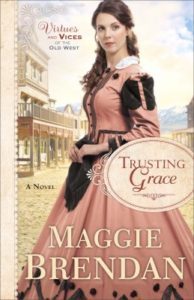 More about Trusting Grace:
More about Trusting Grace:
All of her life, Grace Bidwell has longed for a loving husband and children, but now the chances of her dreams coming true are looking slim. Widowed and caring for her elderly father, she struggles to maintain her late husband’s ranch, until she places an ad for a hired hand.
Robert Frasier arrives in town with three pitiful, bedraggled children who have nothing but the tattered clothes on their backs and a load of hurt, pride, and anger. Believing this is divine intervention in her life, Grace welcomes them with open arms. As feelings grow between her and Robert, Grace will have to convince him that she is a woman who can be trusted with his heart.
Readers will be swept away into 1860s Montana’s lush Gallatin Valley, nestled among towering mountains and proud pines, in this emotional conclusion to the Virtues and Vices of the Old West series.
Purchase a copy here:
Amazon | Barnes and Noble | CBD
 Maggie Brendan is a CBA bestselling author of the Heart of the West, The Blue Willow Brides and Virtues and Vices of the Old West series. Winner of the 2014 Book Buyers Best Award (OCC/RWA) for inspirational fiction and the 2013 Laurel Wreath Award, she was a finalist for the 2013 Published Maggie Award of Excellence and the 2013 Heart of Excellence Readers’ Choice Award. She is married, lives in Georgia, and loves all things Western. She has two grown children and four grandchildren. When she’s not writing, she enjoys reading, researching her next novel, and being with her family.
Maggie Brendan is a CBA bestselling author of the Heart of the West, The Blue Willow Brides and Virtues and Vices of the Old West series. Winner of the 2014 Book Buyers Best Award (OCC/RWA) for inspirational fiction and the 2013 Laurel Wreath Award, she was a finalist for the 2013 Published Maggie Award of Excellence and the 2013 Heart of Excellence Readers’ Choice Award. She is married, lives in Georgia, and loves all things Western. She has two grown children and four grandchildren. When she’s not writing, she enjoys reading, researching her next novel, and being with her family.
Website | Blog | Facebook | Twitter | Pinterest | GoodReads | Instagram






September 20, 2017
Celebrating Fall with Historical Fiction | Karen Witemeyer


One of my favorite moments as a writer is when I stop to research some historical possibility and come away with a fascinating discovery. That happened to me just last week.
In my latest release, Heart on the Line, instead of my usual cowboy hero, I decided to go in a slightly different direction. Instead of riding a horse, my hero prefers a bicycle. Seeing as how I’m married to a computer nerd cyclist and am busy raising two more males of that variety, I thought it was time I showed the world just how hunky and sigh-worthy the atypical romance hero could be.
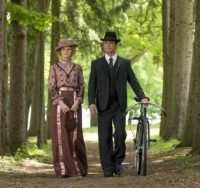 Amos Bledsoe is slim and fit (from all his cycling), has a wonderful sense of humor, is loyal, intelligent, sensitive, and thanks to his great relationship with his sister and mother, insightful when it comes to appreciating a woman’s independence. Yet, his finer qualities are often overlooked because he’s not the rugged outdoorsman with tanned skin and broad shoulders. Even though I love my alpha male heroes, when it comes to a lifetime commitment, I’d much rather have the intelligent, funny, sensitive man than the arrogant, bull-headed fella. So I decided it was past time for me to write one.
Amos Bledsoe is slim and fit (from all his cycling), has a wonderful sense of humor, is loyal, intelligent, sensitive, and thanks to his great relationship with his sister and mother, insightful when it comes to appreciating a woman’s independence. Yet, his finer qualities are often overlooked because he’s not the rugged outdoorsman with tanned skin and broad shoulders. Even though I love my alpha male heroes, when it comes to a lifetime commitment, I’d much rather have the intelligent, funny, sensitive man than the arrogant, bull-headed fella. So I decided it was past time for me to write one.
Loosely inspired by Detective William Murdoch from the Murdoch Mysteries series, Amos is an avid wheelman. However, when he travels to Harper’s Station to help the heroine, he leaves his velocipede behind. Now, seeing as how Harper’s Station is a women’s colony full of suffrage-minded women, and bicycling in the 1890’s was a great symbol of women’s increasing freedom and independence, I knew my ladies would want to take advantage of Amos’s skills and have him give them a few riding lessons. Only problem was, safety bicycles were still so new at this time, they were terribly expensive. So I needed a way for them to get hold of some used machines. Enter, the Alamo Wheelmen.
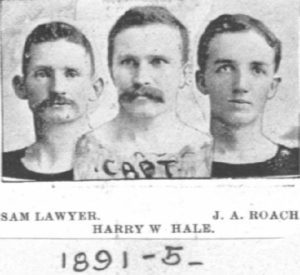

Thanks to the wonderful website of the Texas Transportation Museum, I discovered that bicycles were not only popular back east, but were in use in Texas as well. The Alamo Wheelmen was a cycling club in San Antonio founded in 1891. It was a chapter of the national organization — League of American Wheelmen — of which my hero was also a member. They had their own racing team and had numerous owners of bicycle shops as members as well. The perfect contact for my hero.
So Amos used his connections to contact the Alamo group via telegraph and found a selection of used female-style cycles as well as a more masculine style for himself. And all at a bargain price!
The arrival of those bicycles added some humorous moments to the story as well as a distraction that allowed the villain to move ahead with his dastardly plan. So what do you think?
So what do you think?
Can a western hero ride a bicycle instead of a horse?
Do you enjoy a variety of hero types in your romances, or do you have a strong preference for the alpha males?
‘Can a western hero ride a bicycle instead of a horse?’ Karen Witemeyer is #CelebratingFall!…
Click To Tweet
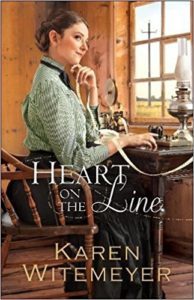 More about Heart on the Line:
More about Heart on the Line:
Witemeyer Returns with Her Trademark Blend of Adventure, Romance, and Humor
Grace Mallory is tired of running, of hiding. But when an old friend sends an after-hours telegraph transmission warning Grace that the man who has hunted her for nearly a year has discovered her location, she fears she has no choice. She can’t let the villain she believes responsible for her father’s death release his wrath in Harper’s Station, the town that has sheltered her and blessed her with the dearest friends she’s ever known.
Amos Bledsoe prefers bicycles to horses and private conversations over the telegraph wire to social gatherings with young ladies who see him as nothing more than an oddity. His telegraph companion, the mysterious Miss G, listens eagerly to his ramblings every night and delights him with tales all her own. For months, their friendship–dare he believe, courtship?–has fed his hope that he has finally found the woman God intended for him. Yet when he takes the next step to meet her in person, he discovers her life is in peril, and Amos must decide if he can shed the cocoon of his quiet nature to become the hero Grace requires.
Purchase a copy here:
Amazon | Barnes and Noble | CBD
 For those who love to smile as they read, bestselling author Karen Witemeyer offers warm-hearted historical romances with a flair of humor, feisty heroines, and swoon-worthy Texas heroes. A transplant from California, Karen came to Texas for college, met a cowboy disguised as a computer nerd, married him, and never left the state that had become home.
For those who love to smile as they read, bestselling author Karen Witemeyer offers warm-hearted historical romances with a flair of humor, feisty heroines, and swoon-worthy Texas heroes. A transplant from California, Karen came to Texas for college, met a cowboy disguised as a computer nerd, married him, and never left the state that had become home.
Winner of the HOLT Medallion, ACFW Carol Award, Inspirational Reader’s Choice Award, National Reader’s Choice Award, and a finalist for both the RITA and Christy Awards, Karen is a firm believer in the power of happy endings. . . and ice cream. She also loves to reward her readers. Every month she gives away two inspirational historical novels to someone from her newsletter list and offers substantial bonus content on her website.
Website | Facebook | GoodReads






September 19, 2017
Celebrating Fall with Historical Fiction | Ann H. Gabhart


Doing research to write a historical novel can be a mixed bag of great moments when just what you need for your story shows up right in front of your eyes or frustrating times when you find out that unless you change history, your character cannot possibly do what you want him to do in the story or be where you thought she was going to be.
Years ago when I was a young writer embarking on my first historical story, I was a little dubious whether I could be successful since history was not my favorite subject in school. Far from it. But I soon discovered that history can be fascinating when you’re reading about people and events you choose to study. Now, with many historical novels under my writing belt, I look forward to the research when I begin fleshing out a new idea for a story. Immersing myself in the history of whatever era and/or event I want to use in my books has a way of opening my creative mind to possibilities about my characters and plots that I might never have imagined until I started doing that vital research.
My new historical novel, These Healing Hills, is no exception. The story set in 1945 in the Kentucky Appalachian Mountains has a background history of the Frontier Nursing Service. This service was founded in 1925 by Mary Breckinridge to bring better healthcare to mothers and children in the mountains. The nurse midwives rode up the mountain trails to care for their patients in their homes.
My research led me to Mary Breckinridge’s autobiography, Wide Neighborhoods that tells the story of how and why she established the Frontier Nursing Service. So then the next step was visiting her Kentucky home, Wendover. Her house, the central headquarters for the FNS while she was living, is now a National Historical Site and operates as a bed and breakfast inn. A beautiful one at that. I liked walking the same paths as Breckinridge and her nurse midwives had done. I saw the river they had to ford on their horses and read about the swinging bridges they sometimes had to cross to get to their patients.
One of the recruitment posters I came across in my research promised every nurse midwife who came to the mountains her own horse, her own dog and plenty of adventure while keeping the mountain children healthy. What nurse could resist that! Certainly not my character in These Healing Hills. And she did get her own horse, her own dog and all that adventure.
A memoir of one of the nurse midwives helped me better understand the trials and yes, adventures the women had in the mountains. One thing they had to learn was the mountain lingo. For example, the mountain people said the nurses came to “catch babies.”
Those kind of unique mountain expressions were wonderful discoveries to slip into my story and perhaps what I enjoyed most in my research. I embraced the poetic sound of the “edge of dark” when people spoke of night was falling. Getting a “soon start” meant beginning early in the morning. Sick children were said to be “punying around,” while a woman in labor might be said to be “punishing bad.” Vegetable gardens were “sass patches,” while a flower bed was a “blossom patch.” These and more like them took me to the mountains to hear the people talking and that helped bring my characters to life.
Then the folk cures were a window to the past when the people had no doctors to treat them and had to come up with their own ways. Some of them were more than a little strange while others made sense. Here’s a quote from a mountain healer I came across in The Wolfpen Notebooks by James Still who spent many years recording the unusual expressions of his mountain neighbors. “There was put here on this earth at the beginning of time all the herbs needed to cure every illness. Hit’s up to us to tinker and experiment and learn what cures what.”
That is sort of what a writer has to do when she is digging back into history to come up with the background and perhaps plot of her story. You have to tinker and experiment and learn what works for your story. I’m glad I was able to do that with mountain ways for These Healing Hills.
Read more about @AnnHGabhart’s research of her new novel These Healing Hills! #CelebratingFall
Click To Tweet
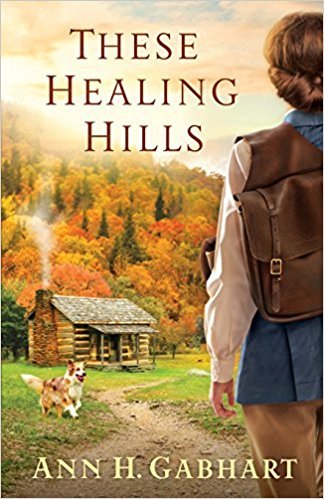 More about These Healing Hills:
More about These Healing Hills:
Francine Howard has her life all mapped out until the soldier she planned to marry at WWII’s end writes to tell her he’s in love with a woman in England. Devastated, Francine seeks a fresh start in the Appalachian Mountains, training to be a nurse midwife for the Frontier Nursing Service.
Deeply affected by the horrors he witnessed at war, Ben Locke has never thought further ahead than making it home to Kentucky. His future shrouded in as much mist as his beloved mountains, he’s at a loss when it comes to envisioning what’s next for his life.
When Francine’s and Ben’s paths intersect, it’s immediately clear that they are from different worlds and value different things. But love has a way of healing old wounds . . . and revealing tantalizing new possibilities.
Purchase a copy here:
Amazon | Barnes and Noble | CBD
 ANN H. GABHART, the bestselling author of over thirty novels, has been called a storyteller, not a bad thing for somebody who grew up dreaming of being a writer. In addition to her popular Harmony Hill Shaker novels, Ann writes about family life in novels like Angel Sister and Love Come Home as well as cozy mysteries (as A.H. Gabhart) set in small towns like the Kentucky town where she grew up. These Healing Hills is her first historical novel set in the Appalachian Mountains. She and her husband have three children and nine grandchildren and enjoy country life in Kentucky.
ANN H. GABHART, the bestselling author of over thirty novels, has been called a storyteller, not a bad thing for somebody who grew up dreaming of being a writer. In addition to her popular Harmony Hill Shaker novels, Ann writes about family life in novels like Angel Sister and Love Come Home as well as cozy mysteries (as A.H. Gabhart) set in small towns like the Kentucky town where she grew up. These Healing Hills is her first historical novel set in the Appalachian Mountains. She and her husband have three children and nine grandchildren and enjoy country life in Kentucky.
Website | Facebook | Twitter | Pinterest | GoodReads






September 18, 2017
Celebrating Fall with Historical Fiction | Christine Johnson


First of all, it’s a thrill and an honor to join fellow historical fiction authors this week on Suzanne Woods Fisher’s blog. I’m especially excited to chat with you, our readers. Since we’re discussing research breakthroughs this week, let me give you the inside scoop on one of the key research moments for Freedom’s Price.
Often my historical romances are set against the backdrop of real events. With the Keys of Promise series set in Key West in the 1850s, it was only natural that I include a wrecker or two in my novels. Wreckers were unique figures in Key West history. They waited eagerly (perhaps too eagerly) for news of a ship wrecked on the reef. The first wrecking vessel to reach the foundered ship took charge of the salvage and reaped the lion’s share of the profits.
Owners and ship masters often considered wreckers little better than pirates. In the early, unregulated days of wrecking, some unscrupulous wreckers colluded with the ship’s master to run the ship aground and split the profits. Rumors persisted of wreckers luring ships onto the reef. In 1828, the territorial government (and, after statehood, the federal government) stepped in to license and regulate the industry. However, the damage to the wrecker’s image was already done. To their credit, wreckers saved the lives of passengers and crew without compensation in a time before the U.S. Lifesaving Service came into existence.
In Freedom’s Price, we find Tom Worthington in charge of his own wrecking vessel. To bring the hero and heroine together, I needed a wreck, or at least a storm. 1856 provided historical evidence of a tropical storm/hurricane that wrecked the sailing ship Isaac Allerton. That fact provided a perfect beginning—except the heroine, Catherine, could not be on board the Allerton, since this vessel didn’t hail from her port of embarkation.
Since the salvage of the Allerton had historically required the assistance of most of the wrecking fleet, Tom would have taken part in the salvage of the Allerton. But if he was wrecking the Allerton, how could he meet Catherine? I decided that the storm could have damaged other ships, perhaps to the point of needing assistance. That solution would bring them together but not for long. Tom would soon depart for the Allerton.
Now, I knew from other accounts that many men lost their lives during salvage—some from diving into the holds of sunken ships and getting trapped, others were crushed between the wrecked ship and the salvage vessel, still others drowned in the heavy seas. In spite of the danger, fortunes could be made. That drove many to wrecking and was a motivation for Tom, who recognized that Catherine came from a much higher class than he did. Only wealth could hope to attract her. That made the risk worthwhile.
Tom had to go to the Allerton.
To make the salvage of a historic shipwreck as realistic as possible, I needed more information, not only on the wrecking process but also on the specific techniques used on the Allerton wreck. This seemed a bit daunting for an island whose records were periodically lost to hurricanes and fires. Then I located the admiralty court record of the Allerton salvage. To my delight, the record includes a description of both the processes used to extract cargo and the dangers faced.
It was exactly what I needed! I could make those salvage scenes tense with danger and based on fact. This was truly unexpected treasure.
All that remained was to thrust Tom into the heart of danger and see if he could survive and earn Catherine’s admiration.
Thank you for visiting today. Have you ever traveled on a ship or a boat? If so, what type? If not, have you toured a historic ship or replica or visited a maritime museum?
Get the inside scoop on the reseach for @ChristineJWrite’s Freedom’s Price (and enter to win a…
Click To Tweet
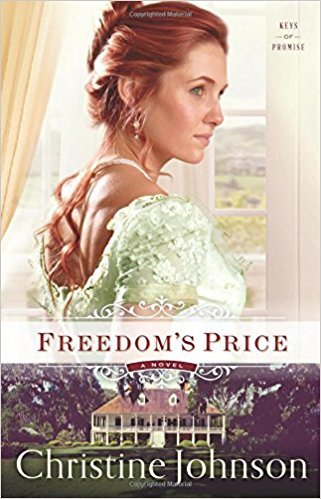 More about Freedom’s Price:
More about Freedom’s Price:
When Englishwoman Catherine Haynes loses both her parents and her home in 1856, she decides to cross the Atlantic to find her American mother’s family in Louisiana. She enlists the help of Tom Worthington, a dashing Key West man who makes his living salvaging wrecked ships, but whose real goal in life is to bring to justice the man who stole his father’s ship and caused his untimely death.
When Catherine finally arrives at her family’s plantation, she finds it in disarray and her family absent landowners. Torn between returning to Key West with Tom or beginning the hard work of restoring the plantation, Catherine soon finds herself snared in a plot to steal her inheritance. When an incredible secret comes to light, both she and Tom will face a choice. Can they relinquish the dreams that have been holding them captive in order to step forward in faith—even if it costs them everything?
Purchase a copy here:
Amazon | Barnes and Noble | CBD
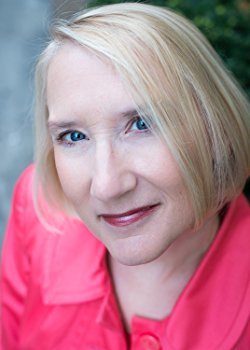
Christine Johnson loves history, especially when it centers on ships and the sea. In addition to her Keys of Promise series with Revell, she has authored a dozen books with Steeple Hill and Love Inspired. She and her ship captain husband split time between the shores of Lake Huron and the Florida Keys.






September 15, 2017
Celebrating Fall with Historical Fiction | Joanna Davidson Politano


Research trips make for wonderfully romantic honeymoons. No really, they do. At least, that’s what I told my husband when I suggested spending two weeks in the UK poking around ruined castles and old estates. Being the wonderful servant-hearted man he is, he dove right into the research for books he’d never read if his wife’s name wasn’t on the cover.
My imagination sparked to life and nearly burst with creativity as we trailed through abandoned estates and crumbling buildings that nearly vibrated with backstory. There’s something undeniably compelling about such places, and I began to see story ideas come to life within the decrepit old buildings. We wrote down absolutely everything, even if it seemed ridiculous—the way the dirt smelled, the exact color of the stones in a cathedral, the view from an eroded tower window—so I could accurately portray it in my books. Then we made up wild stories for all the people who lived in these places and gave them fun histories, passing back and forth story snippets as we toured.
Then came a new aspect of our trip. Research had always been about accuracy, details, and scene painting, but in an estate’s vast gardens, we discovered a heavily whiskered old man wandering about with a camera and tripod, snapping pictures of the beautiful landscaping who provided something more.
I sat down and started talking to him, drawn to his jolly little face and elfish ears that stuck out from under a plaid cap. He was a local man who loved the estate and he’d made it his first subject when he took up photography. In his delightful Scottish accent, he began to tell me about all the families who’d lived in that estate over time, dating back to his boyhood and even his father’s recollections. He’d lived just beyond the estate grounds all his life, and several generations of his family before him. He told me lively little tales of daily life and family secrets, infusing them with the enthusiasm and strong voice of a delightful storyteller.
I remembered then what first drew me to this writing business—stories. Especially when told with the authentic words of one who experienced them. Nothing thrills me more. I soaked up everything this man had to tell me, which made him eager to share more. His tales enchanted me and they validated something in the teller, giving worth to his daily mundane experiences. His chin lifted and his eyes lit as he opened up his life for me in a series of memories and impressions, giving his personal opinion and inside information on the debated secrets of the estate’s families. It’s amazing what people will tell you if you only let them.
It struck me then how terrible and fabulous it would be for this man to have broadcasted or even published these insider observations of the noble families—in secret, of course. Would they recognize themselves? What sort of delightful chaos might it create to have their secrets revealed? It was an irresistible idea that wouldn’t let go of my imagination until I wrote it down a few years later in a Victorian setting, with an anonymous serial novelist for a heroine, and set it in one of the old abandoned estates. Suddenly all the aspects of research—experiencing the setting, noticing details, and personal stories—had come together into what would become my debut novel.
We sat in the airport for our return flight, weaving together all the research we’d collected to create a whole series of possible novels. Interesting faith implications arose from the character struggles and story elements. We discussed it all, and the newlyweds dove into a deeper understanding of one another through this exploration of faith—all because of stories and the sparks they ignite in our hearts and minds. Then, after two solid weeks of touring and experiencing the sights, we flew home to write out all the stories we’d created. Let me tell you, it was a wonderful start to our own story.
“Research trips make for wonderfully romantic honeymoons.” Read @politano_joanna’s story…
Click To Tweet
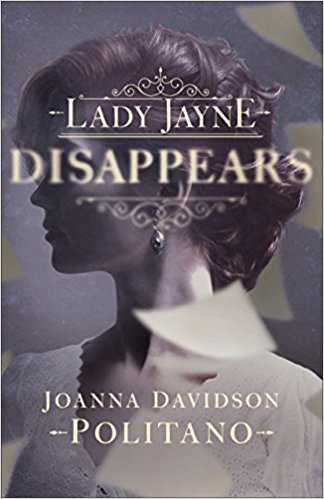 More about Lady Janye Disappears:
More about Lady Janye Disappears:
When Aurelie Harcourt’s father dies in debtor’s prison, he leaves her just two things: his wealthy family, whom she has never met, and his famous pen name, Nathaniel Droll. Her new family greets her with apathy and even resentment. Only the quiet houseguest, Silas Rotherham, welcomes her company.
When Aurelie decides to complete her father’s unfinished serial novel, writing the family into the story as unflattering characters, she must keep her identity as Nathaniel Droll hidden while searching for the truth about her mother’s disappearance—and perhaps even her father’s death.
Author Joanna Davidson Politano’s stunning debut set in Victorian England will delight readers with its highly original plot, lush setting, vibrant characters, and reluctant romance.
Pre-order a copy:
Amazon | Barnes and Noble | CBD
 Joanna Davidson Politano is a freelance writer and debut novelist who spends as much time as possible spinning tales that capture the exquisite details of ordinary lives. She lives with her husband and their two babies in a house in the woods near Lake Michigan. Learn more at www.jdpstories.com.
Joanna Davidson Politano is a freelance writer and debut novelist who spends as much time as possible spinning tales that capture the exquisite details of ordinary lives. She lives with her husband and their two babies in a house in the woods near Lake Michigan. Learn more at www.jdpstories.com.
Website | Facebook | Twitter | Pinterest









